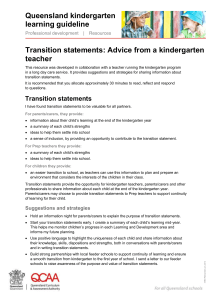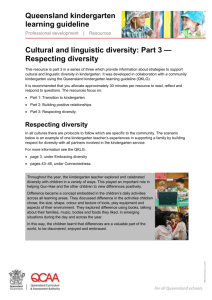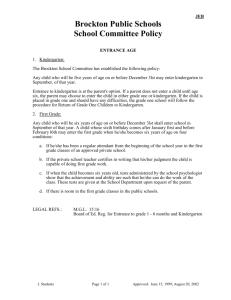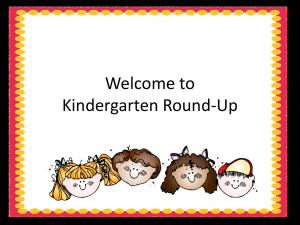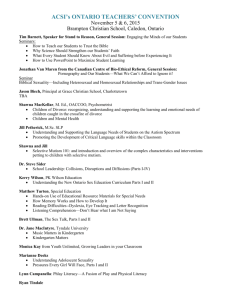Cultural and linguistic diversity: Part 1 — Transition to kindergarten
advertisement
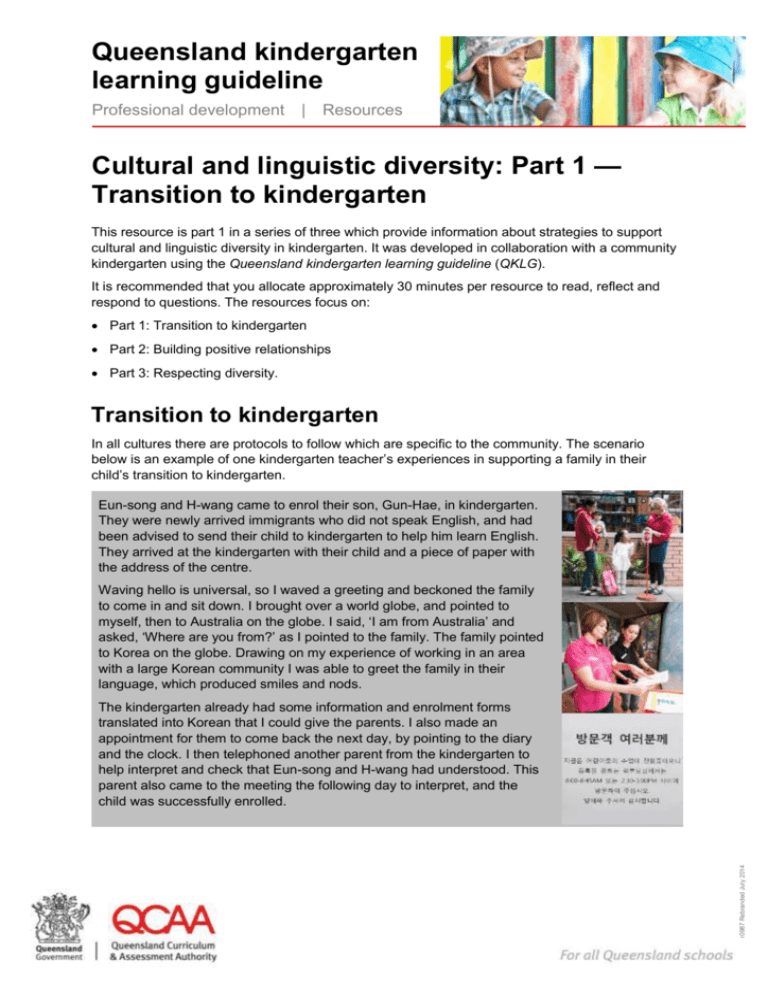
Queensland kindergarten learning guideline Professional development | Resources Cultural and linguistic diversity: Part 1 — Transition to kindergarten This resource is part 1 in a series of three which provide information about strategies to support cultural and linguistic diversity in kindergarten. It was developed in collaboration with a community kindergarten using the Queensland kindergarten learning guideline (QKLG). It is recommended that you allocate approximately 30 minutes per resource to read, reflect and respond to questions. The resources focus on: Part 1: Transition to kindergarten Part 2: Building positive relationships Part 3: Respecting diversity. Transition to kindergarten In all cultures there are protocols to follow which are specific to the community. The scenario below is an example of one kindergarten teacher’s experiences in supporting a family in their child’s transition to kindergarten. Eun-song and H-wang came to enrol their son, Gun-Hae, in kindergarten. They were newly arrived immigrants who did not speak English, and had been advised to send their child to kindergarten to help him learn English. They arrived at the kindergarten with their child and a piece of paper with the address of the centre. Waving hello is universal, so I waved a greeting and beckoned the family to come in and sit down. I brought over a world globe, and pointed to myself, then to Australia on the globe. I said, ‘I am from Australia’ and asked, ‘Where are you from?’ as I pointed to the family. The family pointed to Korea on the globe. Drawing on my experience of working in an area with a large Korean community I was able to greet the family in their language, which produced smiles and nods. r0987 Rebranded July 2014 The kindergarten already had some information and enrolment forms translated into Korean that I could give the parents. I also made an appointment for them to come back the next day, by pointing to the diary and the clock. I then telephoned another parent from the kindergarten to help interpret and check that Eun-song and H-wang had understood. This parent also came to the meeting the following day to interpret, and the child was successfully enrolled. Do your research and ask questions It is important to do some research about the range of cultural groups represented in the local area. You can use this information to help prepare for the diverse families who may access the centre. For example, prepare some information and enrolment forms translated into community languages that can be given to parents/carers. You can find information via: the internet the local Member of Parliament’s (MP’s) office the local corner shop Community Action for Multicultural Society (CAMS) program Local Area Multicultural Partnerships (LAMP) program. Access community support Explore resources in the community that can help you communicate with parents/carers and children who speak languages other than English. The telephone translation service is an excellent tool. There are often parents/carers and friends who are enthusiastic to help. Know how to say ‘hello’ in different languages appropriate to your community. Be prepared to use gestures and visual cues to help communicate. Build inclusive partnerships Some strategies to build inclusive partnerships include: buddy any newcomers with another child, e.g. with a child who shares the same language talk with parents/carers informally in the playground organise a special evening for parents/carers, including an interpreter invite parents/carers to come to the classroom to tell or read stories in their first language and to create dual-language books initiate a world culture day where all the families come together with traditional games, food and costumes organise events throughout the year, e.g. Mother’s day, NAIDOC week celebrations. For more information on building inclusive partnerships see the QKLG, page 22. QKLG Professional development Cultural and linguistic diversity: Part 1 — Transition to kindergarten Queensland Curriculum & Assessment Authority July 2014 Page 2 of 3 Consider these questions as you reflect on ways to explore diversity with children and build respect for differences: 1. What do you know about the cultural groups that are represented in your service/local area? 2. Can you say hello in the languages represented in your local community? Whoever you are, wherever you are, our blood is the same. Whoever you are, wherever you are. Whoever you are, Mem Fox 1997, Voyager, San Diego. More information The QKLG is available at: www.qcaa.qld.edu.au/10192.html. Additional information and resources are available to support cultural and linguistic diversity at: www.qcaa.qld.edu.au/12974.html. QKLG Professional development Cultural and linguistic diversity: Part 1 — Transition to kindergarten Queensland Curriculum & Assessment Authority July 2014 Page 3 of 3

